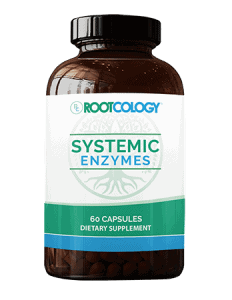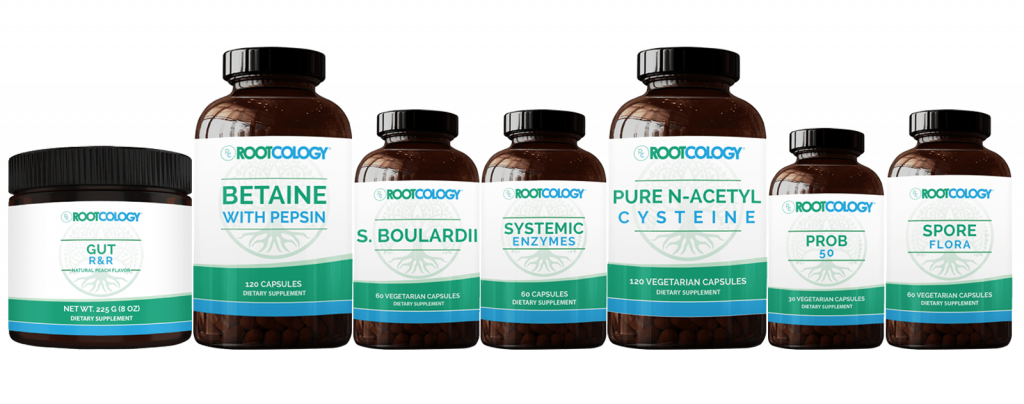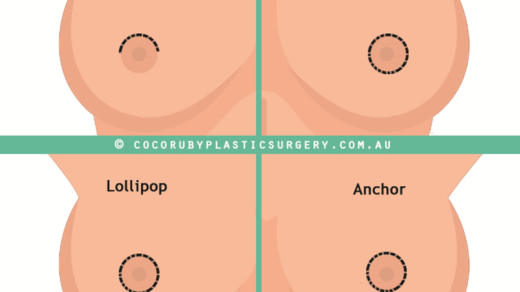Bloating, stomach pain, irritable bowel syndrome (IBS), and acid reflux were a part of my long list of symptoms that I experienced for almost a decade before my Hashimoto’s diagnosis. We often view digestive symptoms as annoying and uncomfortable (I definitely did!), but they’re also very important clues to what’s going on with our health.
Once I began to discover the connection between the gut and Hashimoto’s, I realized that I had an important key in my hands to help me unlock my own remission.
I began digging into the research and learned about the three-legged stool of autoimmunity, a concept presented by Dr. Alessio Fasano, a gastroenterologist and gluten intolerance expert. His research shows that all autoimmune conditions, including Hashimoto’s, consist of three “legs” [1]:
1. A genetic predisposition
2. Exposure to a trigger such as stress, trauma, toxins, or certain medications
3. Intestinal permeability or “leaky gut”
I think we can all agree that we have no control over our genes, and identifying triggering event(s) that initiated our thyroid condition might take quite a bit of time and effort. But addressing leaky gut gives us an actionable pathway to begin healing and puts the power back in our hands, so we can begin the journey toward remission.
I know that getting your health back can feel overwhelming. There’s so much new information to take in, and changing lifelong eating habits can be really challenging! I love functional medicine and can nerd out for hours about the various root causes and triggers of Hashimoto’s. In my early days of working with clients, I would recommend all kinds of testing to find every person’s unique triggers – but while it was helpful, it was also time consuming and expensive. In the last decade or so of working with this condition, I began to notice patterns, and I found that we can accelerate healing by using targeted protocols, regardless of the root cause!
In my book Hashimoto’s Protocol, I talk about the three fundamental protocols: the liver, the adrenal, and the gut protocols! I have created a lot of articles on liver support and adrenal support over the years (and even created live programs for those that want to follow the protocols as a group), but this year, I’ve finally put together a comprehensive guide to my Fundamental Gut Health Protocol, that makes it simple for you to get started on your gut healing journey!
In this article, you’ll learn about:
- The connection between gut and thyroid health
- What leaky gut is and common triggers
- How to assess your gut health
- How to heal using my Fundamental Gut Health Protocol
The Gut-Thyroid Connection
In the areas of natural and functional medicine, there is a widely held understanding that all disease (and thereby all healing) begins in the gut. And for good reason!
The gut performs the all-important role of digesting and absorbing the nutrients we take in, but it is also responsible for helping the immune system recognize foreign invaders from self-antigens, thereby facilitating the control of pathogens and preventing autoimmune reactions. When the health of our gut is compromised, it’s likely that other aspects of our health are affected as well.
Interestingly, the fetal origin of the thyroid gland is the same as the stomach, digestive tract, and tongue. [2] Because of this shared cellular origin, it would seem to make sense that improving digestive function often leads to a significant improvement in thyroid symptoms. This is encouraging news for those experiencing gut and thyroid issues!
While not everyone dealing with Hashimoto’s or leaky gut will experience bloating, stomach pains, irritable bowel syndrome and acid reflux like I did, most people with Hashimoto’s do have some degree of intestinal permeability. Even those who have no apparent gut symptoms may be experiencing intestinal permeability, and for anyone living with an autoimmune condition, addressing gut function might be the best place to start to bring healing to the body.
If we can reverse leaky gut, we can prevent and even reverse autoimmunity.
What is Leaky Gut?
When functioning as they are designed to function, our healthy human intestines serve the role as both a barrier and a filter. A layer of cells form a mucus barrier, consisting of intercellular tight junctions similar to thread fibers that come together to form a piece of cloth. The intestines open and close their tight little junctions to allow nutrients to be absorbed from the food that passes through our gut, as well as block the absorption of toxins like partially digested foods, pollen, feces, dead cells, and bacteria that we certainly don’t want circulating around our bodies. [3]
But what happens when those intestinal tight junctions become damaged and loose?
Those toxic substances become absorbed into the bloodstream, causing the body to recognize them as foreign invaders. This causes inflammation in the body as it begins to attack the intruders, and eventually leads to autoimmunity. According to research from Dr. Alessio Fasano, every person with an autoimmune disorder has some degree of leaky gut. [4]
The discovery that intestinal permeability is a factor in autoimmune thyroid disease, was a major breakthrough in the understanding of the condition.
There are many potential factors that can cause intestinal permeability, and the trigger (or triggers) aren’t the same for everyone. Identifying your personal triggers will be key to restoring your gut. Some of the most common ones that I see are:
How Do We Heal Leaky Gut?
This long list of potential triggers can seem daunting, but the most common triggers that cause leaky gut are stress, food sensitivities, nutrient deficiencies, a deficiency in digestive enzymes, an imbalance of gut bacteria, and intestinal infections (including SIBO). [5]
Through my own experience of healing my gut and putting my Hashimoto’s into remission, and helping thousands of my readers do the same, I learned a lot about what it takes to heal a leaky gut. That’s why I created the Fundamental Gut Health Protocol – so that you can start healing your gut in the most simple and straightforward way possible.
There are four steps to my gut-healing protocol, which will remove some of the triggers I just listed, as well as help you build a stronger, more resilient gut. Here are the four steps:
- Remove reactive foods
- Supplement with enzymes
- Balance the gut flora
- Nourish the gut
I will get into each step in detail in a moment, but first I wanted to address the question – how do I know if I have a leaky gut? I’ve provided my Gut Health Assessment below, so you can better determine your chances of having or developing a leaky gut.
Gut Health Assessment
This is an assessment I’ve adapted from my functional medicine friend, Dr. Mark Hyman. It will help you determine your risk of having or developing a leaky gut. Simply tally up all your symptoms, and see the key at the bottom.
- I have an autoimmune condition
- I have gas
- I have food sensitivities
- I have irritable bowel syndrome
- I have fewer than one bowel movement per day
- I have hard-to-pass stools
- I have diarrhea
- I have constipation
- I have stomach cramps
- I tend to have undigested food in my stools
- I need to take laxatives to have bowel movements
- I have taken antacids (Pepto-Bismol, Maalox, Tums, and so on) more than once in the past year
- I have taken acid-blocking medications like Pepcid, famotidine, Prevacid, omeprazole, Zantac, Nexium, or Prilosec in the last five years
- I have taken antibiotics for more than two weeks
- I have taken more than three courses of antibiotics in the last ten years before my symptoms started
- I have taken a steroid medication like prednisone for more than two weeks in the last ten years before my symptoms started
- I have taken the birth control pill
- I take over-the-counter pain relievers like ibuprofen, Aleve, Advil, or naproxen on a regular basis
- I have skin rashes, acne, or hives
- I have seasonal or environmental allergies
- I have a swollen, patchy, or coated tongue
- I feel bloated after eating, or experience gas or belching
- I have anal itching
- I feel nauseated after eating
- I have foul-smelling stools
- I have cravings for sweets, alcohol, or carbs
- I drink coffee or alcohol on a daily basis
- I frequently eat out
- I like to eat sushi and meat that is undercooked
If you marked fewer than 2 symptoms, your risk for leaky gut is low. If you marked 2 symptoms, you have an intermediate risk for leaky gut; and if you marked 3 or more symptoms, there’s a high likelihood that you’re experiencing some degree of leaky gut.
If you marked down a lot of symptoms, don’t be discouraged! This powerful feedback from your body is information that will help you navigate healing. Feel free to come back to this assessment as you integrate the healing protocol, as a way of tracking your progress.
The Fundamental Gut Health Protocol
This protocol has helped me and thousands of my readers feel better, and I’m so excited to share it with you. By addressing these four foundational steps, you’ll build a stronger, more resilient gut.
Step 1: Remove Reactive Foods
Food sensitivities are one of the most common triggers of leaky gut. In some conditions, a single food can induce intestinal permeability. This is the case with gluten (a protein found in wheat, barley and rye) and celiac disease.[6] Dr. Fasano estimates that for up to 20 percent of people with autoimmune conditions, the trigger may be gluten, and removing gluten will reverse the autoimmunity. [7]
Even in a person without celiac disease or any apparent gluten sensitivity, gluten can lead to a leaky gut because it is a protein that is difficult to digest for humans. [8] While some people with Hashimoto’s go into remission just by removing gluten from their diet, others will have different or additional sensitivities.
The best way to determine your personal sensitivities is through an elimination diet. There are different types of elimination diets out there, but for the purpose of autoimmune thyroid disease, I recommend following the Root Cause Autoimmune Diet. I’ve found this to be most effective in helping you identify the foods that are causing you symptoms, and supporting your gut in the healing process.
You’re going to follow this diet for six to twelve weeks as you work on healing your gut. You should reevaluate your gut function after six weeks and can start reintroducing foods if all of your gut-related symptoms have resolved. If not, I advise you to continue for another six weeks.
The Root Cause Autoimmune Diet
This temporary diet excludes potentially reactive foods that could be contributing to your leaky gut and symptoms.
The Root Cause Autoimmune Diet excludes:
- Caffeine
- Dairy
- Eggs
- Grains
- Legumes
- Nightshades
- Nuts
- Seaweed
- Seeds
- Sugar
The Root Cause Autoimmune Diet includes:
- Fruit, especially coconut
- Meat
- Olive oil
- Shellfish
- Vegetables
I know that this may seem like a very short list of foods to enjoy, but I assure you, you will have plenty of delicious choices to eat. Remember that this diet is temporary, and is a necessary tool in identifying the foods that contribute to your symptoms.
If you need support with recipes and meal ideas, I have plenty of resources. 🙂 Check out my Root Cause Recipe eBooks, and my whole cookbook dedicated to delicious, protocol-friendly meals.
Food sensitivity testing is not necessary, but can be enlightening! It’s how I discovered I was sensitive to dairy – at the time I was having a smoothie with whey protein and yogurt everyday. 🙁 If you’d like to test, I suggest the Alletess Food Sensitivity tests. You can test for the most common 96 foods or dive deeper with the 184 foods panel.
Step 2: Supplement with Enzymes
Several studies have found that people with Hashimoto’s and hypothyroidism often have a deficiency in hydrochloric acid and digestive enzymes, resulting in low levels or even a complete absence of stomach acid. [9] The extra effort it takes to digest food without adequate levels of these two substances can leave someone feeling extra fatigued, not to mention the fact that when we don’t digest our food well, we also do not absorb the nutrients from our food well, which can result in nutrient deficiencies, further exacerbating fatigue!
It’s a vicious cycle, but one that can be slowed by supplementing with the right enzymes, which can assist the body in breaking down these difficult-to-digest proteins and improving overall intestinal function and vitality.
There are a lot of enzyme options to choose from, depending on your individual needs and symptoms (because we are all snowflakes with unique patterns). I wrote an article on the Ultimate Guide to Enzymes last week, but a really great starting point for most people who have Hashimoto’s involves taking betaine with pepsin and systemic enzymes.
These are the two enzymes I chose for the Fundamental Gut Protocol in my Hashimoto’s Protocol book, because most of my clients with Hashimoto’s have found them to be game changers for energy levels, pain, mood, and reducing thyroid antibodies!
Betaine with Pepsin
- Betaine with Pepsin: Betaine HCL and pepsin are naturally occurring components of the gastric juices that break down protein bonds in our food, to make nutrients and amino acids more bioavailable. [10] They are especially important for proper absorption of protein, calcium, B12, and iron. When I first took betaine HCL after struggling for a decade with debilitating fatigue, I was amazed at how my energy returned almost overnight! I no longer needed to sleep for 12 hours, and my bloating was significantly reduced… all because I was finally able to digest my food. Taking betaine HCL with pepsin after every protein-containing meal can assist with digestion and greatly improve energy levels.
Systemic Enzymes
Systemic enzymes, also known as proteolytic enzymes, act as natural immune modulators, meaning they can help bring our immune system into balance. [11] Systemic enzymes are a blend of plant- and animal-derived enzymes.
Systemic enzymes break down inflammatory cytokines that are seen in autoimmune disease, and may also break down pathogens such as bacteria and parasites. [12] These enzymes also speed up tissue repair by reducing inflammation.
Systemic enzymes have been studied extensively in Europe, and have become a popular alternative to pain medications for arthritic disease and many inflammatory conditions. [13]
A poster presentation at the International Congress in Cannes, France, in 2002 found that Wobenzym, a proprietary blend of systemic enzymes, taken at a dose of five tablets three times per day, showed very promising results in Hashimoto’s.
In the study, Hashimoto’s patients on levothyroxine were given systemic enzymes for three to six months. Not only did patients report a reduction of thyroid symptoms, but thyroid ultrasounds also showed normalization. There was a reduced number of inflammatory cells in the thyroid, and significant decreases in TPO and TG antibodies. Many of these patients were able to reduce their dose of levothyroxine, and some were able to discontinue their medications completely.
In my work with Hashimoto’s patients, I’ve seen an equally positive response.
The key to remember about these enzymes is that they are to be taken without food. This means either on an empty stomach, at least forty-five minutes before a meal, or an hour and a half after a meal. If you take them with food or too soon after you’ve eaten, they will get used up in the process of digestion instead of making their way into the bloodstream.
While most systemic enzyme product labels will state to take six capsules daily, this is typically considered to be more of a maintenance dose. The dose of enzymes used in the Cannes study was 2.5 times higher than this, or five capsules three times per day, taken on an empty stomach – and some clinicians will use doses that are even higher than that!
I personally used 10 capsules of systemic enzymes, three times per day on an empty stomach, at one point in my healing journey. I did find that the systemic enzymes reduced my thyroid antibodies, my food sensitivities, and my overall level of inflammation.
However, I did have some big challenges with trying to get my clients to take 30 pills a day on an empty stomach – many thought that it was difficult and impractical to take that many pills per day – not to mention, cost-prohibitive – and though I knew this intervention was promising for many people, it also wasn’t realistic.
When I set out to create my own supplement line, I had a wishlist of products, and two of the top products on that wishlist were:
- A hypoallergenic protein powder (hello AI Paleo Protein)
- Systemic enzymes that didn’t require 30 pills a day to be beneficial 😉
I’m excited to share that Rootcology Systemic Enzymes are finally here! They contain a combination of herbs, nutrients, and proteolytic enzymes that support the clearance of circulating immune complexes, self antibodies, food antibodies, and even thyroid nodules.

And the best part? The starting dose is 2 capsules per day, on an empty stomach. 🙂
I have also had success using Systemic Enzyme Complex from Pure Encapsulations, as well as Wobenzym, in myself and my clients in the past! Please do note that the Pure Encapsulations and Wobenzym brands do require a higher number of daily capsules, anywhere from 6-30 per day!
Step 3: Balance the Gut Flora
Balancing the bacterial flora in the gut can play a critical role in overcoming autoimmune conditions, by helping to heal intestinal permeability. [14] When our bacterial flora is not balanced, this contributes to the autoimmune condition through continuous antigen stimulation. The gut is home to trillions of bacteria, and studies have shown that autoimmune disorders can be brought on by an overabundance of the wrong type of bacteria, and can be reversed by an increase in beneficial bacteria. [15]
Eating a variety of foods contributes to a healthy gut flora. However, this is often challenging to do in the early phases of the gut protocol. During this time, we need to rely on external sources of beneficial flora, including from fermented foods and probiotic supplements.
Fermented Foods
Fermented foods like sauerkraut and other fermented vegetables (that are kept in the refrigerator section of the grocery store or are homemade and refrigerated) have an abundance of beneficial bacteria and can be very helpful in rebalancing the gut flora. [16]
Kefir and yogurt are also filled with good bacteria, but during the elimination diet (or if you’re sensitive to dairy), these options won’t work for you, and I recommend fermented coconut water or fermented coconut yogurt instead.
I have found that most people with Hashimoto’s can really benefit from fermented foods. However, those with small intestinal bacterial overgrowth (SIBO), may have an adverse reaction and should steer clear of fermented foods until they’re further along in their healing journey.
Probiotics
Probiotics are widely used to rebalance the gut flora. The beneficial bacteria in probiotics should help displace the pathogenic bacteria and reestablish the balance we are seeking. [17]
The key with probiotic supplementation is not to overdo it right away, but instead, to focus on starting small and then gradually increasing the dosage until a die-off reaction is felt. A die-off reaction – also known as a Jarisch-Herxheimer reaction – occurs when the dying pathogenic bacteria release endotoxins at a quicker rate than the body can clear them. [18]
Symptoms of a die-off reaction include lethargy, difficulty concentrating, cravings for sweets, diarrhea, rash, irritability, gas, bloating, headache, nausea, vomiting, congestion, and increased autoimmune symptoms. If the die-off reaction is too severe, the dose may be reduced a bit, but it should resolve within three to five days while the probiotic dose is continued. Though the process doesn’t sound fun, many people find that they feel significantly better once they endure the short discomfort!
I’ve found three types of probiotics to be helpful for people with Hashimoto’s: Lactobacillus-based probiotics, Saccharomyces boulardii (S. boulardii), and spore-based probiotics.
- High dose Lactobacillus: Lactobacillus-based (lactic acid) probiotics are the most commonly used and can be very helpful in rebalancing gut dysbiosis. Many people with Hashimoto’s test deficient in these probiotic bacteria on stool tests. While I recommend starting low (1 to 10 billion CFUs per day) and increasing slowly, doses of at least 50 billion CFUs per day are needed for therapeutic effect. These probiotics can be very helpful for people with Hashimoto’s who often show low levels of them on gut lab tests. However, they may be problematic for people with SIBO, which can be caused by an overgrowth of various bacteria. If you have SIBO, consider boulardii instead (more information below). I recommend Rootcology ProB 50, and have also seen benefits from Ther-Biotic Complete by Klaire Labs.
- Saccharomyces boulardii (S. boulardii): S. boulardii is a beneficial yeast that helps to raise our secretory IgA, which acts as a protective barrier in the gut, leading to a removal of opportunistic and pathogenic organisms from the gut, and preventing new infections as well as reinfections. [19] This type of probiotic is an excellent tool for addressing dysbiosis, yeast overgrowth, and parasitic infections, and it can be used concurrently with antibiotics. Furthermore, yeast-based probiotics do not have a propensity to increase SIBO. I recommend a dose of 250 mg to 2,000 mg per day of Rootcology S. Boulardii.
- Spore-based probiotics: Spore-based probiotics came on my radar after some colleagues reported seeing excellent results while using them with their clients. They have shown promise in supporting various autoimmune diseases, as well as in reducing allergies and asthma. [20] They also have an ability to boost Lactobacillus colonies, so they can be used concurrently with Lactobacillus probiotics, as well as in place of them. Unlike Lactobacillus probiotics, spore-based probiotics can reduce SIBO and increase gut diversity by boosting the growth of other beneficial flora. [21] After many years of development, I was excited to finally roll out Rootcology’s Spore Flora, which contains five targeted Bacillus The starting dose for spore-based probiotics is one capsule every other day, and the therapeutic dose is two capsules per day. Once the desired effect has been seen (generally three to six months in people with Hashimoto’s), I recommend dropping down to a maintenance dose of one capsule per day.
With respect to rebalancing the gut flora with probiotics, vs. following more aggressive protocols (like those involving antimicrobial medications and herbs), you will want to use a variety of probiotic strains, in high doses, for a longer period of time. That said, you always want to start low and go slow. While your ultimate target may be to take 3 probiotics at therapeutic doses, you will only start one probiotic, at a small dose, then increase the dose of that probiotic slowly, before introducing a second probiotic, at a low dose, and so on!
Step 4: Nourish the Gut
Removing reactive foods and using enzymes and probiotics will go a long way toward gut repair, but completing those three steps alone might leave you without the support you need to sustain long-term gut health. That’s why I recommend that you nourish your gut with bone broth and add in supplemental L-glutamine, zinc, NAC, omega-3 fatty acids, and vitamin D.
- Bone broth: One of the easiest ways to soothe and heal the lining of the gut is to have a delicious cup of bone broth. Bone broth is a traditional food that we hear a lot about these days because it really is one of the most nourishing foods we can feed our bodies. The reported benefits of bone broth include boosting immunity, relieving joint pain, increasing energy, improving digestion, and giving you a more youthful appearance. [22] Most importantly, for those suffering from leaky gut, the gelatin in bone broth actually helps to seal the junctions in the intestines so they are no longer permeable; and so that toxic substances can no longer pass through the intestinal wall. [23] Check out my simple bone broth recipe here.
- Glutamine: Glutamine is the best-studied substance for healing intestinal permeability. Supplementation of this important amino acid has been found to reduce the leaky gut associated with the use of NSAIDs and abdominal surgery. [24] A deficiency in glutamine is also known to cause increased intestinal permeability in mouse models and malnourished children. [25]
- Zinc: Zinc plays a specific role in gut health, as deficiency has been associated with increased intestinal permeability, susceptibility to infections, and reduced detoxification of bacterial toxins. [26] In conditions such as Crohn’s disease, replenishing zinc has shown to help repair intestinal permeability. [27] Because zinc is not stored in the body, a daily intake is recommended even for the general population, and people with Hashimoto’s and other autoimmune conditions should consider zinc supplementation as part of their everyday regimen.
- You can get zinc and L-glutamine as standalone products, or you can get them in a combination product like Rootcology’s Gut R&R. This is Rootcology’s all-star gut healing supplement that is formulated with L-glutamine, zinc, N-acetyl glucosamine, and DGL, as well as mucilaginous herbs that work in synergy to provide comprehensive support for repairing the gut lining!
- NAC: I consider N-acetylcysteine (NAC) to be a super supplement for people with Hashimoto’s. NAC turns into glutathione and promotes intestinal health by helping to detoxify intestinal bacteria and by breaking down biofilms that house gut pathogens. [28] Hashimoto’s patients are often deficient in the antioxidant glutathione, which helps prevent free radical damage to the thyroid. NAC has been used for healing intestinal permeability and should be taken orally. It’s important to note that it can cause stomach upset if taken on an empty stomach, and should be taken with food.
- Omega-3 fatty acids: These essential fats can help reduce inflammation and are found primarily in fish, shellfish, and flaxseeds, although they can also be taken in supplement form for those who cannot eat adequate amounts of fish or are concerned about mercury content. Omega-3 acid supplementation has been found to be helpful in a variety of autoimmune conditions, and has the power to reduce inflammation. [29] Doses of 1 to 4 g are recommended. I’ve found Pure Encapsulations EPA/DHA Essentials to be effective.
- Vitamin D: The sunshine vitamin plays an important role in immune balance, building resilience against infections, and maintaining gut health. [30] Scientists believe that autoimmune conditions are more likely to cluster in regions farther from the equator because of inadequate vitamin D levels. [31] Vitamin D has been helpful in my recovery, and I’ve found that exposure to sunshine is consistently something that makes my clients and readers feel better. A recommended daily allowance of 400 IU has been established, but studies are showing this is not adequate for most people. I generally recommend 5,000 IU per day as a starting point. However, I also recommend monitoring vitamin D levels to ensure that you are within the optimal range (60 to 80 ng/L). I recommend working with your doctor and testing your levels, as vitamin D can build up in your system.
Fundamental Gut Health Protocol Overview
- Overview: remove reactive foods, supplement with enzymes, balance the gut flora, nourish the gut
- Diet (Root Cause Autoimmune Diet): remove gut-reactive foods, including eggs, nightshades, seeds, and nuts, for six weeks
- Supplements:
- Betaine with pepsin
- Action: helps digest protein-containing meals
- Recommended brand: Rootcology or Pure Encapsulations
- Notes: Take with protein-containing meals. Do not use with ulcers, pylori, NSAIDs, steroids, or proton pump inhibitors, or if burning occurs after taking.
- Systemic enzymes
- Action: break down circulating immune complexes, antibodies to the thyroid gland, and food
- Recommended brand: Rootcology Systemic Enzymes, Pure Encapsulations Systemic Enzyme Complex, or Wobenzym
- Notes: May impact clotting test. Stop for two weeks prior to any surgery.
- Probiotics
- L-glutamine powder
- Zinc
- Action: helps to support the gut barrier
- Recommended brand: find it in Rootcology Gut R&R or Pure Encapsulations as a standalone zinc supplement
- Notes: Take with food. May deplete iron and copper levels.
- N-acetylcysteine (NAC)
- Action: supports liver function, breaks down pathogenic biofilms in the gut, supports glutathione levels
- Recommended brand: Rootcology
- Notes: Take with food. May cause discomfort on an empty stomach.
- Omega-3 fatty acids
- Action: reduces inflammation, supporting gut health
- Recommended brand: Pure Encapsulations
- Notes: If burping occurs after taking, freeze before taking.
- Vitamin D
- Action: supports immune function and gut integrity
- Recommended brand: Pure Encapsulations
- Notes: Please test your levels before supplementing. Start with 5,000 IU per day, then adjust based on lab values. Vitamin D may build up in the body, so retest your levels within 3-6 months of starting supplementation.
- Betaine with pepsin
- Goal: renew bacterial and microbial balance, eliminate digestive distress, reduce autoimmune expression
After the Protocol
I recommend doing the Fundamental Gut Health Protocol for six weeks, and then checking back in with yourself. You may want to retake the gut assessment from earlier in this article, as this can help you track which symptoms have improved.
If you’re feeling better and have noticed a decrease in symptoms, you can begin reintroducing foods, to see which ones are your personal triggers. Introduce one food at a time, allowing several days between reintroductions, to see if you get a reaction. Reactions can come in different forms, including gastrointestinal symptoms, joint pain, fatigue, brain fog, and even breakouts and other skin reactions. Keep in mind that some symptoms can take several days to show up, which is why it’s important to space out reintroductions.
If you’re not feeling better after six weeks, I recommend continuing the protocol for an additional six weeks. It takes a long time for imbalances to show up in our bodies, and it can take some time to reverse them!
If after twelve weeks, you’re still not feeling better, I suspect there might be an additional root cause, like a gut infection, that’s causing your leaky gut.
Since gut infections can lead to intestinal permeability, removing the infections can be the missing link in gut repair. It can be tricky to identify which type of infection is the culprit, but a few common ones I see in my Hashimoto’s clients include: Blastocystis hominis, H. pylori, SIBO, and yeast overgrowth.
If you’ve hit a plateau with your healing and are losing more foods instead of gaining foods back after a “leaky gut protocol”, I recommend pursuing gut testing. However, all gut tests are not created equally! I personally had numerous gut tests show that I was “negative” for a gut infection, before I tested positive for Blastocystis hominis, a potential Hashimoto’s trigger. My current favorite test for gut infections is the GI-MAP stool test, and I’ve recently started using the Gut Zoomer test as well.
I also recommend testing for SIBO. SIBO testing is done via breath testing, like the Small Intestinal Bacterial Overgrowth 3-Hr Lactulose – Genova Kit. Unfortunately, current stool tests do not test for SIBO, and SIBO breath tests will not reveal infections in the stool.
For yeast overgrowth, I recommend the Great Plains Organic Acids Test.
For more information about identifying and treating these infections, you may wish to read the “Advanced Protocols” chapter in my book Hashimoto’s Protocol: A 90-Day Plan for Reversing Thyroid Symptoms and Getting Your Life Back.
If you discover that you do have an intestinal infection, the good news is that you now know one of the root causes of your autoimmune condition and have targeted tools to help you heal. You may need a combination of treatments that might include various types of herbs, as well as antibiotic, antifungal, antiviral or antiprotozoal agents, to eradicate these infections. Each infection will require a different approach, but please believe that with the right support, healing your gut can lead to an elimination of your gut-related symptoms – and recovery is possible!
The Takeaway
If you’re experiencing leaky gut and other disruptive symptoms, and you’re ready to address your gut health, this protocol is tried and true, by myself and thousands of my readers, to improve gut symptoms and reverse autoimmune conditions.
I know it can be overwhelming to get started on a protocol, which is why I’m excited to share with you the Rootcology Fundamental Gut Protocol Kit. Curated by yours truly, the kit includes: Gut R&R, Betaine with Pepsin, S. Boulardii, Systemic Enzymes, NAC, ProB 50, and Spore Flora. Along with diet changes, the kit includes everything you need to get started with the protocol.

I’m so excited for you to start feeling better and wishing you all the best on your healing journey! 🙂
I love interacting with my readers on social media, and I encourage you to join my Facebook, Instagram, TikTok, and Pinterest community pages to stay on top of thyroid health updates and meet others who are following similar health journeys. For recipes, a FREE Thyroid Diet start guide, and notifications about upcoming events, be sure to sign up for my email list!
References:
[1] Fasano A. Leaky gut and autoimmune diseases. Clin Rev Allergy Immunol. 2012;42(1):71-78. doi:10.1007/s12016-011-8291-x.
[2] Rosen RD, Sapra A. Embryology, Thyroid. In: StatPearls. Treasure Island (FL): StatPearls Publishing; May 8, 2022.
[3] Schoultz I, Keita ÅV. The Intestinal Barrier and Current Techniques for the Assessment of Gut Permeability. Cells. 2020;9(8):1909. Published 2020 Aug 17. doi:10.3390/cells9081909
[4] Fasano A. Leaky gut and autoimmune diseases. Clin Rev Allergy Immunol. 2012;42(1):71-78. doi:10.1007/s12016-011-8291-x.
[5] Camilleri M. Leaky gut: mechanisms, measurement and clinical implications in humans. Gut. 2019;68(8):1516-1526. doi:10.1136/gutjnl-2019-318427
[6] Cardoso-Silva D, Delbue D, Itzlinger A, et al. Intestinal Barrier Function in Gluten-Related Disorders. Nutrients. 2019;11(10):2325. Published 2019 Oct 1. doi:10.3390/nu11102325
[7] Fasano A. All disease begins in the (leaky) gut: role of zonulin-mediated gut permeability in the pathogenesis of some chronic inflammatory diseases. F1000Res. 2020;9:F1000 Faculty Rev-69. Published 2020 Jan 31. doi:10.12688/f1000research.20510.1
[8] Columbia researchers find biological explanation for wheat sensitivity. Columbia University Irving Medical Center. https://www.cuimc.columbia.edu/news/columbia-researchers-find-biological-explanation -wheat-sensitivity-0. Published July 26, 2016. Accessed November 11, 2022.
[9] Wiersinga WM, Touber JL. The relation between gastrin, gastric acid and thyroid function disorders. Acta Endocrinol (Copenh). 1980;95(3):341-349. doi:10.1530/acta.0.0950341
[10] Yago MR, Frymoyer AR, Smelick GS, et al. Gastric reacidification with betaine HCl in healthy volunteers with rabeprazole-induced hypochlorhydria. Mol Pharm. 2013;10(11):4032-4037. doi:10.1021/mp4003738
[11] Farhadi SA, Bracho-Sanchez E, Freeman SL, Keselowsky BG, Hudalla GA. Enzymes as Immunotherapeutics. Bioconjug Chem. 2018;29(3):649-656. doi:10.1021/acs.bioconjchem.7b00719
[12] Nouza K. Outlooks of systemic enzyme therapy in rheumatoid arthritis and other immunopathological diseases. Acta Univ Carol Med (Praha). 1994;40(1-4):101-104.; Rodeheaver G, Marsh D, Edgerton MT, Edlich RF. Proteolytic enzymes as adjuncts to antimicrobial prophylaxis of contaminated wounds. Am J Surg. 1975;129(5):537-544. doi:10.1016/0002-9610(75)90313-x
[13] Jadhav SB, Shah N, Rathi A, Rathi V, Rathi A. Serratiopeptidase: Insights into the therapeutic applications. Biotechnol Rep (Amst). 2020;28:e00544. Published 2020 Oct 17. doi:10.1016/j.btre.2020.e00544
[14] Chakaroun RM, Massier L, Kovacs P. Gut Microbiome, Intestinal Permeability, and Tissue Bacteria in Metabolic Disease: Perpetrators or Bystanders?. Nutrients. 2020;12(4):1082. Published 2020 Apr 14. doi:10.3390/nu12041082
[15] Wu HJ, Wu E. The role of gut microbiota in immune homeostasis and autoimmunity. Gut Microbes. 2012;3(1):4-14. doi:10.4161/gmic.19320
[16] Leeuwendaal NK, Stanton C, O’Toole PW, Beresford TP. Fermented Foods, Health and the Gut Microbiome. Nutrients. 2022;14(7):1527. Published 2022 Apr 6. doi:10.3390/nu14071527
[17] Raheem A, Liang L, Zhang G, Cui S. Modulatory Effects of Probiotics During Pathogenic Infections With Emphasis on Immune Regulation. Front Immunol. 2021;12:616713. Published 2021 Apr 8. doi:10.3389/fimmu.2021.616713
[18] Belum GR, Belum VR, Chaitanya Arudra SK, Reddy BS. The Jarisch-Herxheimer reaction: revisited. Travel Med Infect Dis. 2013;11(4):231-237. doi:10.1016/j.tmaid.2013.04.001
[19] Terciolo C, Dapoigny M, Andre F. Beneficial effects of Saccharomyces boulardii CNCM I-745 on clinical disorders associated with intestinal barrier disruption. Clin Exp Gastroenterol. 2019;12:67-82. Published 2019 Feb 11. doi:10.2147/CEG.S181590
[20] McFarlin BK, Henning AL, Bowman EM, Gary MA, Carbajal KM. Oral spore-based probiotic supplementation was associated with reduced incidence of post-prandial dietary endotoxin, triglycerides, and disease risk biomarkers. World J Gastrointest Pathophysiol. 2017;8(3):117-126. doi:10.4291/wjgp.v8.i3.117
[21] Marzorati M, Van den Abbeele P, Bubeck S, Bayne T, Krishnan K, Young A. Treatment with a spore-based probiotic containing five strains of Bacillus induced changes in the metabolic activity and community composition of the gut microbiota in a SHIME® model of the human gastrointestinal system. Food Res Int. 2021;149:110676. doi:10.1016/j.foodres.2021.110676
[22] Mar-Solís LM, Soto-Domínguez A, Rodríguez-Tovar LE, et al. Analysis of the Anti-Inflammatory Capacity of Bone Broth in a Murine Model of Ulcerative Colitis. Medicina (Kaunas). 2021;57(11):1138. Published 2021 Oct 20. doi:10.3390/medicina57111138
[23] Paray BA, Albeshr MF, Jan AT, Rather IA. Leaky Gut and Autoimmunity: An Intricate Balance in Individuals Health and the Diseased State. Int J Mol Sci. 2020;21(24):9770. Published 2020 Dec 21. doi:10.3390/ijms21249770
[24] Rao R, Samak G. Role of Glutamine in Protection of Intestinal Epithelial Tight Junctions. J Epithel Biol Pharmacol. 2012;5(Suppl 1-M7):47-54. doi:10.2174/1875044301205010047
[25] Ueno PM, Oriá RB, Maier EA, et al. Alanyl-glutamine promotes intestinal epithelial cell homeostasis in vitro and in a murine model of weanling undernutrition. Am J Physiol Gastrointest Liver Physiol. 2011;301(4):G612-G622. doi:10.1152/ajpgi.00531.2010
[26] Skrovanek S, DiGuilio K, Bailey R, et al. Zinc and gastrointestinal disease. World J Gastrointest Pathophysiol. 2014;5(4):496-513. doi:10.4291/wjgp.v5.i4.496
[27] Sturniolo GC, Di Leo V, Ferronato A, D’Odorico A, D’Incà R. Zinc supplementation tightens “leaky gut” in Crohn’s disease. Inflamm Bowel Dis. 2001;7(2):94-98. doi:10.1097/00054725-200105000-00003
[28] Wang C, Su B, Lu S, et al. Effects of Glutathione on Growth, Intestinal Antioxidant Capacity, Histology, Gene Expression, and Microbiota of Juvenile Triploid Oncorhynchus mykiss. Front Physiol. 2021;12:784852. Published 2021 Nov 29. doi:10.3389/fphys.2021.784852
[29] Hahn J, Cook NR, Alexander EK, et al. Vitamin D and marine omega 3 fatty acid supplementation and incident autoimmune disease: VITAL randomized controlled trial. BMJ. 2022;376:e066452. Published 2022 Jan 26. doi:10.1136/bmj-2021-066452
[30] Zmijewski MA. Vitamin D and Human Health. Int J Mol Sci. 2019;20(1):145. Published 2019 Jan 3. doi:10.3390/ijms20010145
[31] Sharpe RJ. The low incidence of multiple sclerosis in areas near the equator may be due to ultraviolet light induced suppressor cells to melanocyte antigens. Med Hypotheses. 1986;19(4):319-323. doi:10.1016/0306-9877(86)90104-0
Note: Originally published in August 2018, this article has been revised and updated for accuracy and thoroughness.







